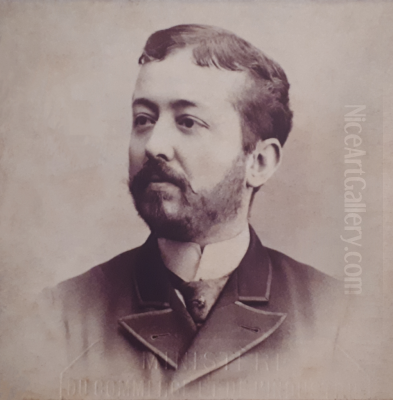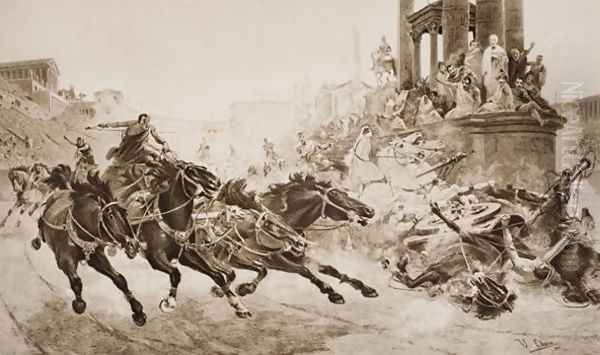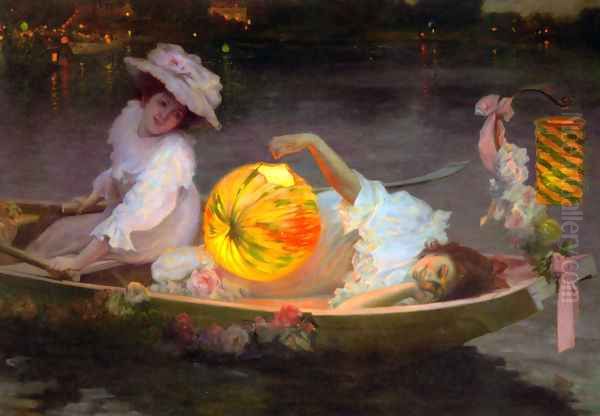
Ulpiano Checa y Sanz stands as a significant, if sometimes internationally underappreciated, figure in Spanish art at the turn of the 20th century. A painter, sculptor, and illustrator, Checa carved a niche for himself with his dramatic historical paintings, often characterized by dynamic compositions, a profound understanding of equine anatomy, and a unique blend of academic precision with a more modern sensibility. His life and career spanned a period of great artistic ferment, and his work offers a fascinating window into the tastes and preoccupations of his time.
Early Life and Artistic Awakening in Colmenar de Oreja
Ulpiano Checa Sanz was born on April 3, 1860, in Colmenar de Oreja, a small town in the province of Madrid, Spain. This rural upbringing, while perhaps modest, did not stifle his innate artistic talents, which became apparent from an early age. His family, recognizing his potential, supported his artistic inclinations. Colmenar de Oreja itself, with its historic architecture and surrounding landscapes, may have provided early visual stimuli for the young artist, instilling in him a sense of history and place that would later manifest in his grander compositions.
The artistic environment in Spain during Checa's youth was dominated by the Royal Academy of Fine Arts of San Fernando in Madrid, the premier institution for artistic training. It was the aspiration of many young Spanish artists to study there, and Checa was no exception. His early promise paved the way for formal artistic education, a crucial step in honing his natural abilities and exposing him to the techniques and traditions of European art.
Formative Years at the Royal Academy of San Fernando

Checa's journey into the formal art world began in earnest when he enrolled at the prestigious Real Academia de Bellas Artes de San Fernando in Madrid. This institution was a bastion of academic art, emphasizing rigorous training in drawing, anatomy, perspective, and the study of Old Masters. During his time at the Academy, Checa would have been under the tutelage of prominent Spanish artists of the era. Figures like Federico de Madrazo, a leading portraitist and history painter, or Alejandro Ferrant y Fischermans, known for his historical and religious scenes, were influential professors whose teachings shaped a generation of Spanish artists.
At the Academy, Checa distinguished himself, demonstrating a remarkable aptitude for draftsmanship and a keen interest in historical subjects. The curriculum would have included copying classical sculptures and Renaissance masterpieces, instilling a deep respect for tradition. It was here that he likely began to develop his fascination with dramatic narratives and complex, multi-figure compositions, hallmarks of his later, mature style. The academic environment, while sometimes criticized for its conservatism, provided Checa with a solid technical foundation upon which he would build his career.
The Roman Sojourn: Broadening Horizons
Following his studies in Madrid, and in a tradition common for promising European artists of the time, Checa traveled to Rome to further his artistic education. The Spanish Academy in Rome (Academia de España en Roma) was a key institution for Spanish artists awarded scholarships, offering them the opportunity to immerse themselves in the classical and Renaissance heritage of Italy. While it's confirmed he studied at the "Bellas Artes" (Fine Arts Academy) in Rome, the direct influence of the city itself was paramount. Rome, with its ancient ruins, magnificent churches, and world-class museums, was a living textbook of art history.
In Rome, Checa would have encountered a vibrant international community of artists. He deepened his understanding of classical art and was exposed to the works of Italian masters. This period was crucial for his development, allowing him to refine his skills and broaden his artistic vision. The city's rich historical tapestry undoubtedly fueled his passion for historical painting. He would have studied the works of Renaissance and Baroque masters like Raphael, Michelangelo, and Caravaggio, absorbing lessons in composition, color, and dramatic lighting. It was also in Rome that he likely began to solidify his interest in depicting scenes from antiquity, a theme that would become central to his oeuvre. The influence of contemporary Roman academic painters, or other international artists working there, such as the Dutch-born British artist Lawrence Alma-Tadema, known for his meticulous depictions of Roman life, might also have been felt.
Paris: The Crucible of International Acclaim

After his formative years in Spain and Italy, Ulpiano Checa moved to Paris in 1889, a city then considered the undisputed capital of the art world. This move marked a significant turning point in his career. Paris offered unparalleled opportunities for artists: prestigious Salons, influential dealers, and a dynamic, competitive artistic environment. Checa quickly established himself, and his work began to gain international recognition. He participated regularly in the Paris Salon, a critical venue for artists seeking to build their reputations.
His dramatic and often action-packed historical paintings resonated with French audiences and critics. He achieved notable success, winning a gold medal at the Exposition Universelle (World's Fair) in Paris in 1889 for his work. This was a significant honor that cemented his status as an important international artist. He also received an award in Vienna in 1890, further testament to his growing fame. While he became well-known and respected in France and Italy, his recognition in his native Spain, though present, was comparatively less pronounced during his lifetime, a common fate for many Spanish artists who found greater success abroad, such as his contemporary Joaquín Sorolla, though Sorolla eventually achieved immense fame in Spain as well.
Artistic Style: A Fusion of Academicism and Dynamic Realism
Ulpiano Checa's artistic style is a compelling blend of rigorous academic training and a more modern, dynamic sensibility. His foundation was firmly rooted in the academic tradition, evident in his precise draftsmanship, meticulous attention to anatomical detail (especially in his famed depictions of horses), and his preference for historical and mythological subjects. He was a master of composition, capable of orchestrating complex, multi-figure scenes with a sense of order and dramatic impact. His works often recall the grand manner of historical painting championed by French academic artists like Jean-Léon Gérôme or Ernest Meissonier, who were renowned for their historical accuracy and technical polish.
However, Checa's work was not merely a staid repetition of academic formulas. He infused his paintings with a remarkable sense of energy and movement. His brushwork, while often controlled, could also exhibit a certain vivacity, and his use of color, sometimes leaning towards cooler palettes, effectively conveyed mood and atmosphere. There's a palpable dynamism in his battle scenes and chariot races, capturing the chaos and excitement of the moment. Some art historians note a fusion of Impressionistic touches, particularly in his handling of light and atmosphere in certain passages, with traditional techniques, though he never fully embraced Impressionism in the way artists like Claude Monet or Pierre-Auguste Renoir did. His primary aim was narrative clarity and dramatic storytelling, often with a romantic or heroic undertone.
Masterpieces of Historical Drama
Ulpiano Checa is perhaps best known for his large-scale historical paintings, which vividly brought to life dramatic episodes from the past. Among his most celebrated works is The Invasion of the Barbarians (also sometimes referred to in relation to The Fall of Rome or similar titles depicting barbarian incursions). This painting, for which he won a National Gold Medal in Spain in 1887, exemplified his ability to capture the turmoil and ferocity of ancient warfare. Although the original canvas was reportedly destroyed, sketches and photographs attest to its power and complexity, showcasing charging warriors, rearing horses, and a scene of epic struggle. This work, and others like it, placed him in the lineage of great history painters such as the French artist Eugène Delacroix, though Checa's style was generally more polished and less overtly Romantic.
Another iconic work is his Roman Chariot Race. This subject, popular in late 19th-century art and literature (famously depicted in Lew Wallace's novel Ben-Hur), allowed Checa to showcase his extraordinary skill in rendering horses in motion. The painting is a tour-de-force of dynamic composition, with thundering hooves, straining charioteers, and the dust and excitement of the ancient circus. The meticulous detail in the chariots, costumes, and the architectural setting demonstrates his commitment to historical verisimilitude, a quality highly valued in the historical genre painting of the era, akin to the works of artists like Georges Rochegrosse or Jean-Paul Laurens who also tackled grand historical narratives.
The Ubiquitous Horse: A Defining Motif
A defining characteristic of Ulpiano Checa's art is his profound love and mastery in depicting horses. These noble animals feature prominently in a vast number of his paintings, not merely as accessories but often as central figures conveying power, speed, and wild energy. Whether in his Roman chariot races, barbarian invasions, scenes of Attila and the Huns, or depictions of Native American life such as The Redskins, Checa's horses are rendered with anatomical precision and a palpable sense of life.
He captured their musculature, their varied gaits, and their expressive qualities with an expertise that few of his contemporaries could match. This skill set him apart and contributed significantly to the dynamism of his compositions. His ability to portray horses in complex, foreshortened poses and in moments of intense action was remarkable. This focus on equine subjects aligns him with a tradition of animalier painters, but Checa integrated this skill seamlessly into his broader historical and genre scenes, much like earlier masters such as Théodore Géricault, whose The Raft of the Medusa also showcased powerful equine forms in other contexts. Checa's passion for horses was not just technical; it was an integral part of his artistic vision, imbuing his works with a unique vitality.
Versatility: Beyond Historical Epics
While historical paintings formed the core of Ulpiano Checa's reputation, his artistic talents extended to other genres and media. He was a capable sculptor, though his work in this field is less widely known than his paintings. This three-dimensional understanding likely contributed to the solidity and anatomical correctness of his painted figures. Furthermore, Checa was an accomplished illustrator, lending his skills to various publications. Notably, he wrote a preface for a book on Napoleon, indicating his intellectual engagement with historical subjects beyond their purely visual representation.
His thematic range also included mythological scenes, such as Amazonas, and depictions of ancient Roman life that went beyond warfare, like Saturnalia, capturing the revelry of the Roman festival. He also explored religious themes, as seen in works like La Anunciación de la Virgen (The Annunciation of the Virgin). A particularly intriguing piece is Time, which personifies death or the passage of time as an elderly, cloaked figure on horseback, showcasing his ability to tackle allegorical subjects with originality. He even designed a puzzle titled Carnival Eve, a rare example of an artist of his stature engaging with more popular forms of visual culture. This versatility demonstrates a broad artistic curiosity and a willingness to apply his skills across different domains.
Checa and His Contemporaries: A Place in Art History
Ulpiano Checa operated within a vibrant and diverse European art scene. In Spain, his contemporaries included luminaries like Joaquín Sorolla, renowned for his sun-drenched beach scenes and portraits; Ignacio Zuloaga, known for his darker, more traditionally Spanish themes; and the Catalan modernistas Santiago Rusiñol and Ramón Casas, who were bringing new artistic currents to the Iberian Peninsula. While Checa's style differed from these artists, particularly from the Impressionistic leanings of Sorolla or the Symbolist undertones of Rusiñol, he shared with them a commitment to technical excellence and a desire to engage with significant themes. His historical focus was perhaps more aligned with earlier Spanish masters like Francisco Pradilla Ortiz, famous for his historical painting Joanna the Mad.
In Paris, Checa would have been aware of the dominant academic figures like William-Adolphe Bouguereau and Jean-Léon Gérôme, as well as the ongoing impact of Impressionism and Post-Impressionism. His success in the Paris Salons indicates that his work, while perhaps seen as more traditional by the avant-garde, appealed to the prevailing tastes for well-executed, narrative paintings. His focus on Orientalist and ancient world themes also connected him to a broader European trend, with artists like Gustave Boulanger or Benjamin-Constant in France, and Sir Lawrence Alma-Tadema in Britain, achieving great success with similar subjects. Checa carved out his own space within this complex landscape, distinguished by his dynamic compositions and unparalleled depiction of horses.
Later Years and Enduring Legacy
Ulpiano Checa continued to work and exhibit throughout his career, maintaining a significant output. Despite his international success, particularly in France, he remained deeply connected to his Spanish roots. He passed away on January 5, 1916, in Dax, a spa town in southwestern France, at the relatively young age of 55 (or 56, depending on the exact date of death relative to his birthday). His death occurred during the tumultuous period of World War I, an event that would profoundly reshape the European cultural landscape.
Perhaps the most significant testament to his legacy is the Museo Ulpiano Checa, located in his hometown of Colmenar de Oreja. Established through the efforts of his descendants and local authorities, this museum is dedicated to preserving and promoting his work. It holds a substantial collection of his paintings, sketches, sculptures, and personal effects, making it one of the largest single-artist museums and an invaluable resource for scholars and art enthusiasts. His works continue to be admired for their technical skill, dramatic power, and historical imagination. While perhaps not as universally famous as some of his contemporaries, Ulpiano Checa y Sanz remains an important figure in Spanish art, a master of historical narrative and a peerless painter of the horse, whose art continues to captivate viewers with its energy and spectacle. His paintings have also served as visual references for theatrical and film productions dealing with historical subjects, a nod to their evocative power and perceived accuracy.
Conclusion: The Enduring Appeal of Checa's Art
Ulpiano Checa Sanz was an artist of considerable talent and ambition, who successfully navigated the competitive art worlds of Madrid, Rome, and Paris. His dedication to historical painting, combined with his exceptional ability to depict horses in dynamic motion, secured him a distinctive place in late 19th and early 20th-century European art. While trends in art shifted dramatically during his lifetime and after his death, with the rise of modernism, Checa's work retains its power to impress through its technical mastery, narrative force, and sheer visual excitement.
His legacy, anchored by the dedicated museum in his hometown, ensures that his contributions to Spanish and international art are not forgotten. For those who appreciate meticulously crafted historical scenes, dramatic compositions, and the timeless beauty of the equine form, the art of Ulpiano Checa Sanz offers a rich and rewarding experience, reflecting a period when grand narrative painting still held a powerful sway over the public imagination. He remains a testament to the enduring appeal of skilled draftsmanship and epic storytelling in the visual arts.